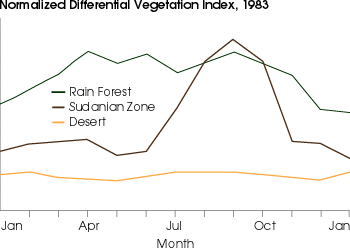

| The Problems in Uncovering Land Cover
Researchers have used remote sensing to map vegetation for years. The categories are often well defined and can be used for plots of land around the world. However, many categories scientists attempt to map are not so easy to discern from the satellite data. Frequently, the types of land cover a research group wishes to measure are too interspersed for the satellite to see. For example if a satellite has a resolution of 30 meters, it cannot distinguish any land features smaller than a 30x30-meter square. If two categories, such as parking lots and lawns, vary greatly over a plot of this size, the satellite will not be able to tell which percentage of each covers the land. Ground-based measurements and aerial photographs would have to be employed to get an accurate reading. |

Land Cover Classification | ||
 |

Another challenge researchers face is in finding just the right color combinations of light to identify specific types of land cover, or information about these land covers. Unlike the example given above, there is usually no simple difference formula available to retrieve the categories from raw satellite images. For instance, in the Pacific Northwest, researchers from the Bureau of Land Management and the U.S. Forest Service are using Landsat 5 in an attempt to map the average size of trees throughout the conifer forests. The purpose of these maps is to help other scientists monitor old-growth forests there. Going into the project no one had a predefined method of manipulating the satellite images to give them a view of these attributes. To find the best color combination, researchers first had to travel into the field and determine the average size of trees over a number of forest test plots. They then acquired Landsat 5 images of these same test plots. All six reflected colors observed by Landsat 5 were mixed and matched and analyzed in a number of ways until the scientists found the combination of reflected wavelengths that accurately described the tree sizes on the test plots. With this template, they were then able to determine the size of trees on plots that had not been tested beforehand. In general, the more specific a category is, the more ground and airplane surveys are needed. However, even if researchers can only get by with mapping half of a given area with the satellite, it is usually far cheaper and much less time consuming than any other survey method. back: The Basic Vegetation Map
|